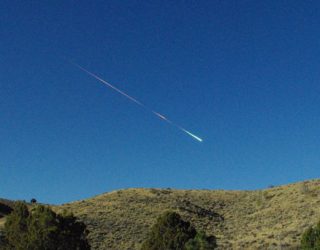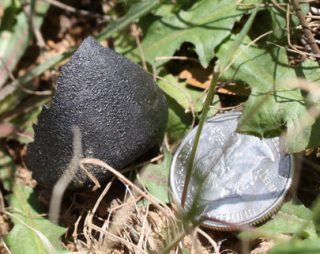
On the morning of April 22, 2012, a meteor the size of a minivan plunged toward the earth and burst through the earth’s atmosphere traveling faster than the speed of sound. People throughout California and Nevada witnessed a bright fireball and heard a long sonic boom as the meteor broke into several pieces, generating the energy equivalent to a several-kiloton explosion, and scattered meteorite fragments throughout the Coloma-Lotus Valley, in the foothills of the Sierra Nevada Mountains.
This is not the first time this picturesque region of northern California has attracted world-wide attention. Coloma is the same small town where gold was first discovered at Sutter’s Mill in 1848, sparking the California Gold Rush, and the arrival of some 300,000 immigrants hoping to strike it rich. With meteorite fragments selling for 20 times the price of gold, people are once again flocking to the Coloma-Lotus Valley to seek their fortune.
Meteorite Fever

Scientists and treasure hunters searched for meteorite fragments in fields and hillsides and even chartered a Zeppelin from Airship Ventures to search from the sky. Local residents rallied together to assist with the recovery efforts and were praised for their support and generosity in allowing strangers on their property to search for pieces of the meteorite. The first discovery was made two days after the fall by Robert Ward, an avid meteorite hunter, and soon more ecstatic people were making discoveries. According to the Meteoritical Society, as of May 22, 2012, 49 meteorite fragments have been recovered with a total mass of 437 grams, the largest of which weighed around 42 grams. Robert Ward not only discovered the first meteorite fragment, but he discovered the 42-gram specimen as well.
Officially named the Sutter’s Mill Meteorite, it is one of the rarest types of meteorites, known as a carbonaceous chondrite. The last major carbonaceous chondrite discovery occurred in Australia in 1969, the same year we landed on the moon. These types of meteorites are more than four and a half billion years old, older than the Earth, and contain water, carbon, and other organic compounds that may help scientists solve mysteries around the formation of our solar system and the origins of molecules necessary for life.
Join the Hunt
NASA and the SETI Institute continue to lead coordinated searches in the area in an effort to recover additional pieces from the Sutter’s Mill Meteorite. According to the SETI Institute, meteorite fragments will have a smooth black exterior, and the interior will be black with tiny white flecks. Meteorite fragments are very fragile and should be handled as little as possible. If you think you’ve found a meteorite, please do the following:
- Note the location as precisely as possible and take photographs of the meteorite and the surrounding location
- Place the meteorite in aluminum foil to keep it clean
- If you have GPS, record the coordinates of the find location
- Notify Peter Jenniskens at (650) 810-0216 or petrus.m.jenniskens@nasa.gov
The picturesque Coloma-Lotus Valley has so much to offer including whitewater recreation, award-winning wineries, a rich gold discovery history, and with our very own meteorite, you never know what treasures you will discover here.
For more information about the Sutter’s Mill Meteorite, please visit these sites:




